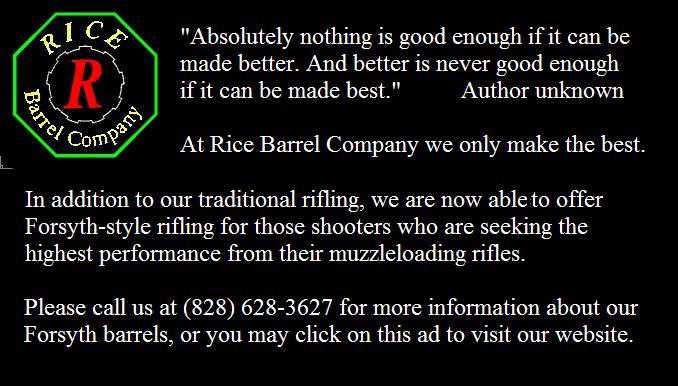After all, it was for the most part that same "not good enough" attitude and Yankee ingenuity that really sparked the whole underhammer revolution in the first place shortly after Reverend Forsyth hit upon the percussion cap idea back in 1807, or thereabouts. (No, I don’t believe he was a relative of Capt. James Forsyth of later Forsyth rifling fame).
Once the percussion cap made its way across the pond, it seems that every backwoods blacksmith and gunmaker in the newly formed united States of America was developing his own version of an underhammer action to take advantage of the new ignition system. Gone was the need of complex and expensive English flintlocks or the newly developed caplocks that evolved from them. Most anyone with half a lick of sense and some basic tool working skills could make a serviceable underhammer action and ultimately a rifle - or shotgun - with little trouble.
I really admire those few makers of today who take the time to design and build their own underhammer actions. I know that many more underhammer builders probably would also do so if they had the skills, tools, and facilities to fabricate - and the time. Sometimes you have to make a priority decision whether to spend your time designing and fabricating an underhammer action, or to just build your rifle with existing components and get into the field or range to shoot it. As for me, it seems that I’m spending far more time these days dreaming up and fabricating new designs and less time actually shooting them. But, that’s okay as it’s my choice – for now.
Richard Holmes is one of us who have to have it our own way. So he created his own underhammer action and a rifle design that is also quite unique - even down to the barrel configuration. Clicking on any of the photos will enlarge them for closer viewing of the rather unique design features of the Holmes Underhammer. Clicking the "Back" button on your browser will return you to the text.
According to Richard, “The receiver starts off as a piece of bar stock 5/8” wide. The two ends are machined to accept the cup rings. The 5/8” bar stock is also turned down on the breech end to 5/8” round by 1” long and threaded to form the breech plug screw. The back end is drilled and tapped to accept the stock bolt”
“To assemble the rifle, you put the front ring on then screw the barrel onto the breechplug and torque it down. You then add the two wooden inserts (both ends of the inserts are recessed to fit in the half moon recesses in the cups) and put the rear cup on, which is recessed on both sides. The stock is also recessed to fit into the rear cup recess. Then slip the stock onto the receiver and torque it down with the drawbolt.”
“Both the barrel and the buttstock are tightly torqued to the receiver. There is also a .004"- thick annealed copper washer that fits between the front nose of the breech plug and the front-inside shoulder of the barrel threads so that as you tighten the barrel the copper washer work hardens and completely seals the breech.”
“I expect that this rifle will take a large powder charge and the extra weight will help check the recoil although the exact charge will be determined when the rifle is bench tested at 50 and 100 yards. I want as flat a trajectory as I can get without decreasing accuracy and I want to shoot semi-hard balls with a temper about half way between linotype and pure lead. For better ignition I prefer musket caps.”
The rear sight is a peep and has an aperture diameter of .250” and is adjustable for elevation. The large aperture makes the sight act like a ghost ring sight. The front sight leaf is pure silver, somewhat fat, and will be modified when the rifle is sighted in.”
Clicking on these sight photos will enlarge them so you can more readily
see the flat-topped and bottom barrel design.
see the flat-topped and bottom barrel design.
“The finished rifle weighs in at 9 pounds as indicated on my scale.”
“So there’s my underhammer rifle. I made the whole rifle, lock, stock, barrel and screws. The only things I bought were the steel and the wood blank.”
Photos copyright claimed by Richard Holmes
Thank you, Richard, for sharing your ideas and your work with us. What isn't readily apparent in the photos is Richards use of the tail of his mainspring to reach up inside the action and provide double duty as his trigger return spring. Also, in case you didn't catch it, Richard and his brother also make their own barrels on a hand-operated rifling machine which they also built.
Well, friends and neighbors, there you have it. Another successful build. And this one from scratch!
Just as a footnote, I want to commend Richard for incorporating a safety notch in his lockwork. I know some of you are probably tired of hearing my rants about underhammer safety, but usually stupid does, and should, hurt, and in the worst cases it's deadly. I just don't want anyone bringing any more undue negative attention to our favored activities because of their stupidity in designing and/or making an underhammer, or any firearm for that matter, without proper consideration for the safe handling and use thereof.
Enough said. NOT!
Be safe!
Cheers!
.









2 comments:
How are you securing you ramrod pipes to the barrel?
Hi there, Anonymous.
I just got the skinny from Richard and he said that the ramrod ferrules are silver brazed to the bottom rib and the rib is soldered to the bottom of the barrel.
Any other questions?
No? Well, carry on.
Post a Comment